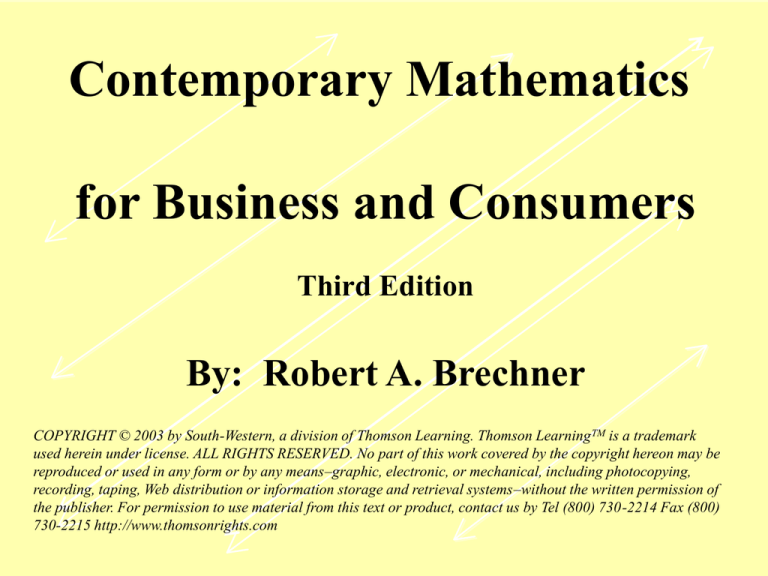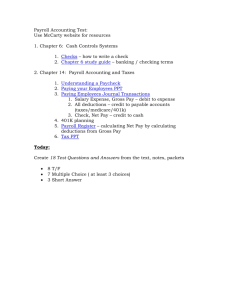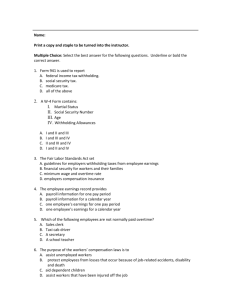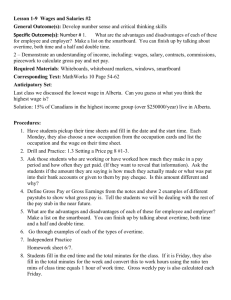
Contemporary Mathematics
for Business and Consumers
Third Edition
By: Robert A. Brechner
COPYRIGHT © 2003 by South-Western, a division of Thomson Learning. Thomson Learning TM is a trademark
used herein under license. ALL RIGHTS RESERVED. No part of this work covered by the copyright hereon may be
reproduced or used in any form or by any means–graphic, electronic, or mechanical, including photocopying,
recording, taping, Web distribution or information storage and retrieval systems–without the written permission of
the publisher. For permission to use material from this text or product, contact us by Tel (800) 730-2214 Fax (800)
730-2215 http://www.thomsonrights.com
Chapter 9
Payroll
Copyright © 2003 by South-Western
Chapter 9, Payroll
Section I Employee’s Gross Earnings and
Incentive Pay Plans
9-1 Prorating annual salary on the basis of weekly,
biweekly, semimonthly, and monthly pay periods.
9-2 Calculating gross pay by hourly wages, including
regular and overtime rates.
9-3 Calculating gross pay by straight and differential
piecework schedules.
9-4 Calculating gross pay by straight and incremental
commission, salary plus commission, and drawing
account.
Chapter 9, Payroll (Cont.)
Section II Employee’s Payroll Deductions
9-5 Computing FCIA taxes, both social security and
Medicare, withheld from an employee’s paycheck.
9-6 Calculating an employee’s federal income tax
withholding (FIT) by percentage method.
9-7 Determining an employee’s total withholding for
federal income tax, social security, and Medicare using the
combined wage bracket tables.
Chapter 9, Payroll (Cont.)
Section III Employee’s Payroll Expenses and Record
Keeping Responsibilities
9-8 Computing FICA tax for employers and selfemployment tax for self-employed persons.
9-9 Computing the amount of state unemployment taxes
(SUTA) and federal unemployment tax (FUTA).
9-10 Calculating employer’s fringe benefit expense.
9-11 Understanding Internal Revenue Service payroll
forms.
Chapter 9, Payroll
Gross pay, or gross earnings
Net pay
or net earnings or take-home pay
Hourly wag, or hourly rate
Double time
Straight piecework plan
Commission
Incremental Commission
Drawing account
or draw against commission
Overtime
Time-and-a-half
Wages
Salary
piecework
Differential piece work
Straight commission
Salary plus commission
Chapter 9, Payroll (Cont.)
Commission
Incremental Commission
Drawing account,
or draw against commission
Deductions, or withholdings
Federal Insurance Contributions Act
or (FICA)
Social security tax
or (QASD)
Combined wage bracket tables
Federal Unemployment Tax Act or (FUTA)
State Unemployment Tax Act or (SUTA)
Straight commission
Salary plus commission
Mandatory deductions
Voluntary deductions
Wage base
Federal income tax
Percentage method
Fringe benefits
Medicare tax
Perquisites, or perks
Cafeteria-style or
Flexible benefit program
Section I, Employee’s Gross Earnings and
Incentive Pay Plans
9-2 Calculating Gross Pay by Hourly Wages, Including
Regular and Overtime Rates
Steps to Calculate an Employee’s Gross Pay by Hourly Wages:
Step 1. Calculate an employee’s regular gross pay for working 40
hours or less:
Regular pay = Hourly rate x Regular hours worked
9-2 Calculating Gross Pay by Hourly Wages,
Including Regular and Overtime Rates
Steps to Calculate an Employee’s Gross Pay by Hourly
Wages:
Step 1. Calculate an employee’s regular gross pay for working 40
hours of less:
Regular pay = Hourly rate X Regular hours worked
Step 2. Calculate an employee’s overtime pay by chain multiplying
the hourly rate by the overtime factor by the number of overtime
hours.
Overtime pay = Hourly rate X Overtime factor X Overtime hours worked
9-2 Calculating Gross Pay by Hourly Wages,
Including Regular and Overtime Rates (Cont.)
Steps to Calculate an Employee’s Gross Pay by Hourly
Wages:
Step 3. Calculate total gross pay:
Total gross pay = Regular pay + Overtime pay
Everybody’s Business
Payroll is a very important business responsibility.
Employees must be paid on a regular basis, and accurate
records must be kept for government reporting.
Payroll is usually one of the largest “expense” categories
of a company.
The department responsible for the payroll functions may
be called Payroll, Personnel, or Human Resources.
In recent years, companies have evolved that specialized in
doing payroll. When a business hires an outside firm to
perform a function such as payroll, this is known as
outsourcing.
9-3 Calculating Gross Pay by Straight and
Differential Piecework Schedules
Steps to Calculate Gross Pay by Piecework:
Straight Piecework:
Step 1. Total gross pay under a straight piecework schedule is
calculated by multiplying the number of pieces or output units by the
rate per unit.
Total gross pay = Output quantity X Rate per unit
Differential Piecework:
Step 1. Multiply the number of output units at each level by the rate
per unit at that level.
Step 2. Find the total gross pay by adding the total form each level.
9-4 Calculating Gross Pay by Straight and
Incremental Commission, Salary Plus Commission,
and Drawing Accounts
Steps to Calculate Gross Pay by Commission:
Straight Commission:
Step 1. Total gross pay under a straight commission schedule is
calculated by multiplying the total sales or output units by the
commission rate.
Total gross pay = Total sales X commission rate
Incremental Commission:
Step 1. Multiply the total sales at each level by the rate for that level.
Step 2. Find the total gross pay by adding the total form each level.
Section II, Employee’s Payroll Deductions
9-6 Calculating an Employee;s Federal Income Tax
Withholding (FIT) by the Percentage Method.
Steps to Calculate the Income Tax Withheld Using the Percentage
Method:
Step 1. Using the proper payroll period, multiply one withholding
allowance, Exhibit 9-2, by the number of allowance claimed by the
employee.
Step 2. Subtract that amount from the employee’s gross earnings
to find the wages subject to federal income tax.
Step 3. From Exhibit 9-3, locate the proper segment (Table1, 2, 3,
or 4) corresponding to the employee’s payroll period. Within that
segment, use the left side (a) for single employees and the right
side (b) for married.
Section II, Employee’s Payroll Deductions (Cont.)
9-6 Calculating an Employee;s Federal Income Tax
Withholding (FIT) by the Percentage Method.
Steps to Calculate the Income Tax Withheld Using the Percentage
Method:
Step 4. Locate the “Over-” and “But not over-” brackets
containing the employee’s taxable wage from Step 2. The tax is
listed to the right as a percent or a dollar amount and a percent.
9-7 Determining to Find Total Income Tax, Social Security,
and Medicare Withheld by Using the Combined Wage bracket
method
9-7 Steps to Find Total Income Tax, Social Security, and Medicare
Withheld by Using the combined Wage Bracket Method.
Step 1. Based on the employee’s martial status and period of payment,
find the corresponding table (Exhibit 9-4 or 9-5).
Step 2. Note that the two left columns, labeled “At least” and “But
less than” are the wage brackets. Scan down these columns until you
find the bracket containing the gross pay of the employee.
Step 3. Scan across the row of that wage bracket to the intersection of
the column containing the number of withholding allowances claimed
by the employee.
Step 4. The number in that column, on the wage bracket row, is the
amount of combined tax withheld.
Everybody’s Business
All employees must have a Social Security number.
Applications are available at all U. S. post offices.
Social Security numbers are used by the IRS as a taxpayer
identification number as well as by banks, credit unions,
and other financial institutions for reporting income from
savings and other investments.
Information about an individual’s Social Security account
can be obtained by filing a Form 7004-SM-Request for
Earnings and Benefit Estimate Statement. These can be
obtained by calling the Social Security Administration ar
1-800-772-1213
Section III, Employer’s Payroll Expense and
Record Keeping Responsibilities
9-10 Calculating Employer’s Fringe Benefit Expense
Steps to Calculate an Employer’s Fringe Benefits Expense:
Step 1. If the fringe benefit is a percent of gross payroll, multiply
that percent by the amount of the gross payroll. If the fringe
benefit is a dollar amount per employee, multiply that amount by
the number of employees.
Step 2. Find the total fringe benefits by adding all individual
fringe benefit amounts.
Step 3. Calculate the fringe benefit percent by using the
percentage formula. Rate = Portion / Base, with total fringe
benefits as the portion and gross payroll as the base (remember to
convert your answer to a percentage).
Fringe benefit percent = Total fringe benefit
Gross payroll
9-11 Understanding Internal Revenue Service
Payroll forms
Form 1040 – ES, Estimated Quarterly Tax Voucher for Self
Employed Persons
Quarterly earnings = Estimated annual earnings
4 (quarters)
Everybody’s Business
Penalties apply if you do not make required deposits on time, make
deposits for less than the required amount, or if you do not use EFTPS
when required, for amounts not deposited properly or in a timely
manner, the penalty rates are:
Penalty
Reason for Penalty
2%
Deposit made 1 to 5 days late
5%
Deposit made 6 to 15 days late
10%
Deposit made 16 or more days late
10%
Not using EFTPS when required
15%
Amounts still unpaid more than
10 days after IRS notice
Chapter 9
Hourly Wages
Regular pay = Hourly rate x Regular hours worked
Overtime pay =
Hourly rate x Overtime factor x Overtime hours worked
Total gross pay = Regular pay + Overtime pay
Piecework
Total gross pay = Output quantity x Rate per unit
Copyright © 2003 by South-Western
Chapter 9
Commission
Total gross pay = Total sales x Commission rate
Payroll Deductions
Total deductions = Social Medicare Income Voluntary
+
+
+
security
Tax
deductions
Net pay = Gross pay - Total deductions
Copyright © 2003 by South-Western
Chapter 9
Fringe Benefits
Fringe benefits percent = Total fringe benefits
Gross payroll
Estimated Quarterly Tax
Quarterly earnings =
Estimated annual earnings
4(quarters)
Copyright © 2003 by South-Western







